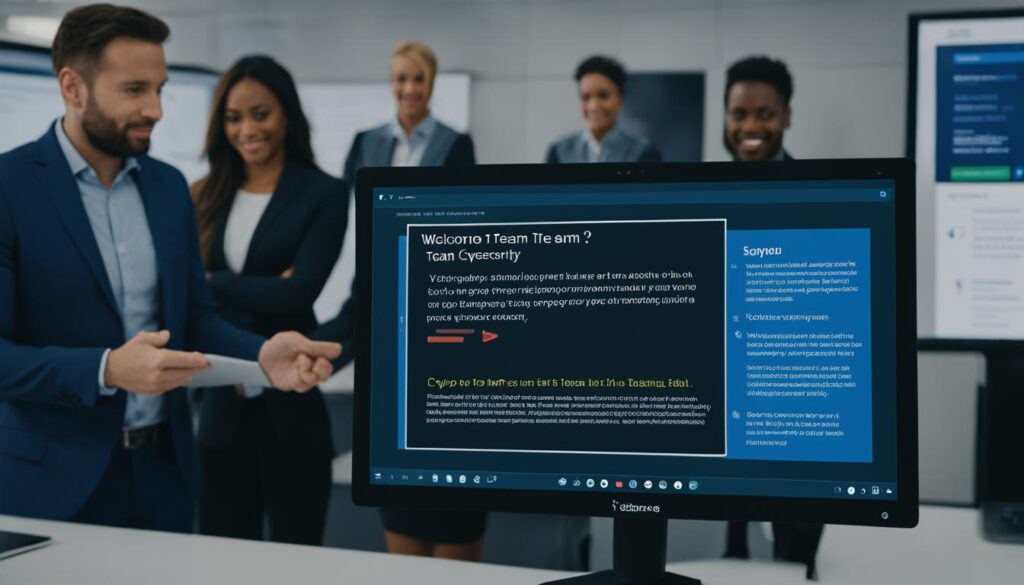Welcome to our comprehensive guide on how to onboard an executive assistant. The onboarding process for an executive assistant is crucial to their success in supporting your daily operations. By following a structured onboarding process, you can ensure that your executive assistant is integrated seamlessly into your organization and equipped with the necessary resources and information. In this article, we will explore the key steps involved in onboarding an executive assistant, as well as the importance of effective onboarding practices. Let’s dive in!
Key Takeaways:
- Onboarding an executive assistant is essential for their successful integration into the organization.
- A well-designed onboarding process provides the assistant with the necessary resources and training to perform their role effectively.
- The key steps in onboarding an executive assistant include introducing them to the team, clarifying expectations, providing necessary access, and establishing communication channels.
- Ongoing practices such as fostering a positive working relationship and recognizing their contributions are crucial for their long-term success.
- Leveraging the executive assistant’s skills and experience can greatly benefit the executive and the organization.
The Importance of Onboarding an Executive Assistant
The onboarding process for an executive assistant is crucial for their successful integration into the organization. It sets the foundation for their role and ensures they have the necessary information, resources, and training to perform effectively. An effective executive assistant onboarding program provides a structured approach to help them understand their responsibilities, establish clear communication channels, and build relationships with key stakeholders.
During the executive assistant orientation, they are introduced to the organization’s culture, values, and mission, allowing them to align their work with the overarching goals. This orientation process creates a sense of belonging and purpose, enhancing their engagement and commitment to their role.
One key aspect of the executive assistant onboarding process is the design and implementation of a comprehensive training program. This program equips the executive assistant with the necessary skills and knowledge to support the executive’s needs effectively. It may include training on relevant software and tools, communication techniques, project management, and other essential skills.
By investing in executive assistant training, organizations can enhance their assistants’ abilities to anticipate needs, prioritize tasks, and manage their time efficiently. This training ensures that the executive assistant is well-prepared to handle complex tasks and contribute to the executive’s workflow seamlessly.
In addition to providing the necessary skills, an executive assistant training program also supports professional growth and development. It encourages continuous learning and helps the assistant stay updated with the latest industry trends and practices. By investing in their professional growth, organizations can retain talented executive assistants and foster long-term partnerships.
Effective executive assistant onboarding, orientation, and training programs contribute to the success of the executive-assistant partnership. They empower executive assistants to excel in their roles, support executives effectively, and contribute to the organization’s overall productivity and success.
Key Steps in Onboarding an Executive Assistant
To ensure a seamless onboarding process for an executive assistant, it is important to follow key steps that will set them up for success from day one. By implementing these best practices, you can create an effective executive assistant induction process that maximizes their productivity and fosters a positive working relationship.
Introduce to the Team and Stakeholders
One of the first steps in onboarding an executive assistant is to introduce them to the team and relevant stakeholders. This helps them understand the organizational dynamics and build connections with key individuals who they will be interacting with. Take the time to provide an overview of each team member’s role and how they contribute to the organization’s success. Encourage open communication and collaboration from the start.
Clarify Expectations and Roles
Clearly defining expectations and roles is essential to a successful executive assistant onboarding process. Sit down with the assistant and discuss their responsibilities, tasks, and priorities. Ensure they have a clear understanding of what is expected of them and the goals they should strive to achieve. This clarity enables them to align their efforts with your vision and work efficiently.
Provide Access to Systems and Tools
An important part of onboarding an executive assistant is providing them with access to the necessary systems and tools they need to perform their duties effectively. This can include granting them login credentials for software platforms, email accounts, and any other tools they will utilize. Ensure they have all the resources required to carry out their tasks seamlessly.
Create a Personalized Training Plan
Every executive assistant is unique, with different skill sets and areas of expertise. To support their growth and development, create a personalized training plan that aligns with their goals and the needs of the role. Identify areas where additional training or guidance is required and provide resources or opportunities for professional development. This investment in their skill enhancement will contribute to their long-term success.
Establish Communication and Feedback Channels
Effective communication is crucial in any professional relationship. During the onboarding process, establish clear communication channels with your executive assistant to ensure seamless collaboration. Encourage open dialogue, provide regular feedback, and be responsive to their questions and concerns. This fosters a positive working environment and strengthens the partnership between you and your assistant.

Successful Onboarding Practices
Successfully onboarding an executive assistant requires more than just providing initial orientation and training. Ongoing practices aimed at fostering a positive working relationship, effectively communicating, and promoting executive assistant productivity are key to their long-term success.
One way to ensure a positive working relationship is by setting clear goals. By clearly defining expectations and targets, you can provide your executive assistant with a clear direction and purpose. This clarity empowers them to perform at their best and contribute effectively to the organization.
Additionally, providing regular feedback is essential. Regular check-ins and performance evaluations allow you to provide guidance, recognize achievements, and address any areas for improvement. By offering constructive feedback, you can help your executive assistant grow and develop in their role.
Another critical aspect of successful onboarding is recognizing the contributions of your executive assistant. Expressing gratitude and acknowledging their efforts go a long way in building trust, motivation, and job satisfaction. When your executive assistant feels valued and appreciated, they are more likely to be engaged and productive.
Encouraging open communication is also crucial for effective onboarding. Create an environment where your executive assistant feels comfortable sharing their thoughts, concerns, and ideas. Actively listen to their input and involve them in decision-making processes when appropriate. This open dialogue fosters trust, strengthens the working relationship, and promotes teamwork.
To maximize executive assistant productivity, you can provide ongoing support and mentorship. This may involve offering professional development opportunities, assigning challenging projects to enhance their skills, and helping them navigate their career path.
Key Points:
- Set clear goals to provide direction and purpose for your executive assistant.
- Provide regular feedback to guide their development and address areas for improvement.
- Recognize their contributions to build trust, motivation, and job satisfaction.
- Encourage open communication to foster a strong working relationship and promote teamwork.
- Offer ongoing support and mentorship to maximize executive assistant productivity and growth.
By incorporating these successful onboarding practices into your partnership with your executive assistant, you can set the foundation for a dynamic, productive, and mutually beneficial working relationship.
Leveraging the Executive Assistant’s Skills and Experience
Executive assistants possess a wealth of experience and expertise that can greatly benefit executives. By mining their past experience and tapping into their knowledge, executives can gain valuable insights and creative thinking. This can involve utilizing the executive assistant’s network, seeking their input on strategic decisions, and delegating tasks that align with their strengths. By recognizing and leveraging the executive assistant’s skills, executives can enhance their own productivity and optimize the overall effectiveness of their partnership.
Unlocking Insights and Creativity
One of the key ways to leverage the executive assistant’s skills is by mining their past experience. Their diverse background and previous roles can provide unique perspectives and insights that executives may not have considered. By actively seeking their input, executives can benefit from their creativity and problem-solving abilities. This collaborative approach fosters a dynamic partnership and encourages innovation within the organization.

Utilizing Networks and Connections
Executive assistants often have a vast network of contacts and connections accumulated throughout their careers. This network can be a valuable resource for executives looking to expand their own connections or seek input from industry experts. By utilizing the executive assistant’s network, executives can leverage their relationships and access a broader collective knowledge base. This not only enhances decision-making but also opens doors to new opportunities for the organization.
Task Delegation and Optimization
To maximize productivity, executives can delegate tasks that align with the executive assistant’s skills and expertise. By understanding their capabilities and strengths, executives can effectively assign responsibilities and empower the executive assistant to excel in their role. This allows executives to focus on strategic and high-priority matters, while still ensuring that important tasks are executed efficiently. Through effective task delegation, the executive assistant can contribute significantly to the overall success of the executive and the organization.
In conclusion, leveraging the executive assistant’s skills and experience is a powerful strategy for maximizing productivity and achieving success. By tapping into their past experience, utilizing their expertise, and delegating tasks that align with their strengths, executives can build a strong partnership and unlock the full potential of their executive assistant. The collaborative efforts between executives and executive assistants not only enhance individual performance but also drive the overall effectiveness of the organization.
Confidentiality and Professionalism
Confidentiality is a critical aspect of the executive assistant role. As an executive, it is imperative to establish clear guidelines and expectations regarding the handling of confidential information. By entrusting your executive assistant with sensitive data, you need to ensure that they understand the importance of safeguarding this information and maintaining professionalism at all times.
Building trust is key in maintaining confidentiality. By fostering a culture of trust, you can create an environment where your executive assistant feels comfortable and confident in handling sensitive information. This includes providing them with the necessary tools and training to handle confidentiality and enforcing safe practices in their daily tasks.
A professional executive assistant understands the importance of discretion and has the ability to maintain confidentiality. They are committed to upholding the privacy and reputation of the organization and the executive they support. By maintaining professionalism, they demonstrate integrity in their work and adhere to ethical principles.
Key Considerations for Maintaining Confidentiality and Professionalism:
- Establish clear guidelines for handling confidential information.
- Provide necessary resources and training to handle confidentiality with care.
- Emphasize the importance of discretion and professionalism in all interactions.
- Foster a culture of trust by building strong relationships and open lines of communication.
- Regularly review and reinforce confidentiality policies and best practices.
- Recognize and acknowledge the contributions of your executive assistant in handling sensitive information.
Remember, building trust and maintaining professionalism with your executive assistant is crucial for a successful partnership. By prioritizing confidentiality, you can create a secure and productive work environment. Trust your executive assistant to handle sensitive information responsibly, and they will become your most valuable ally in managing your daily operations.
Conclusion
In conclusion, onboarding an executive assistant is a critical process that sets the foundation for their success within the organization. By following the key steps outlined in this article, you can create a positive onboarding experience that promotes long-term productivity and collaboration.
Building a strong working relationship with your executive assistant is crucial. Clear communication, mutual understanding of expectations, and regular feedback are essential for establishing trust and fostering a productive partnership.
Furthermore, leveraging the skills and expertise of your executive assistant can greatly benefit your own productivity. By tapping into their past experiences, utilizing their networks, and delegating tasks that align with their strengths, you can unlock their full potential, ultimately enhancing your own effectiveness.
Finally, maintaining confidentiality and professionalism is of utmost importance. Clearly outlining guidelines for handling confidential information and promoting a culture of professionalism will solidify the trust between you and your executive assistant.
FAQ
Why is onboarding an executive assistant important?
Onboarding an executive assistant is important because it sets them up for success and ensures they have the necessary resources, information, and training to perform their roles effectively.
What are the key steps in onboarding an executive assistant?
The key steps in onboarding an executive assistant include introducing them to the team and stakeholders, clarifying expectations and roles, providing access to necessary systems and tools, creating a personalized training plan, and establishing regular communication and feedback channels.
How can executives promote a positive working relationship with their executive assistants?
Executives can promote a positive working relationship with their executive assistants by setting clear goals, providing regular feedback, recognizing their contributions, and fostering open communication.
How can executives leverage the skills and experience of their executive assistants?
Executives can leverage the skills and experience of their executive assistants by tapping into their past experience and knowledge, seeking their input on strategic decisions, and delegating tasks that align with their strengths.
Why is confidentiality important in the executive assistant role?
Confidentiality is important in the executive assistant role because it ensures the protection of sensitive information and maintains professionalism. Executives should establish clear guidelines and expectations regarding the handling of confidential information.
How can executives build trust with their executive assistants?
Executives can build trust with their executive assistants by maintaining open lines of communication, fostering a supportive work environment, and demonstrating their reliability and integrity.




